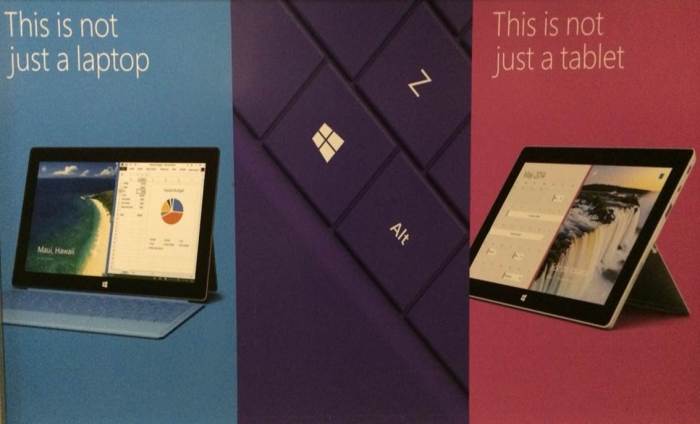Every morning I see this billboard ad in Boston’s South Station:
The ad is for the struggling Surface 2 tablet. Unable to build momentum since the launch of the original Surface in late 2012, Microsoft has doubled down on marketing its combined laptop/tablet product, and these ads have run for months.
Visually the images are eye-catching, reflecting the company’s new colorful aesthetic. And it does a nice job conveying the core marketing messages: this product combines a laptop and tablet; it’s for both work and play; it’s new yet familiar, etc.
But it was the middle image in particular that stuck out to me. It’s obviously intended to highlight the Type Cover keyboard, and the closeup frames the key with the new Windows logo. But it’s slightly off-center, so that the eye also focuses on the Alt key.
And that’s what stopped me. Why Alt?
Alt has been standard on PC keyboards since at least 1981, and has been lodged next to the Windows key since 1994. Its original purpose was as a modifier, multiplying the possible keystrokes one could input, before the advent of the graphical user interface obsoleted that need. Today, most Windows PC users only use it for a few idiosyncratic functions, like Alt-Tab to switch between windows and the infamous Control-Alt-Delete for logging in and calling up the task manager.
In other words, the Alt key is the quintessential vestige, like the human tailbone – an anachronism. No one designing a new keyboard or operating system de novo today would include it. True to form, Apple – famed for ruthlessly eliminating features that begin to outlive their usefulness – didn’t include Alt on the iOS keyboard for iPhone and iPad. So why has Microsoft kept it?
This gets to the heart of why Microsoft is being disrupted. Every business and product line accumulates barnacles, but for a long time, Microsoft had far more to lose from defeaturing the products at the center of its near-perfect business model than it stood to gain from tearing things down and starting over. When that’s been true for long enough, an organization becomes incapable of severing its vestigial organs and designing from scratch. And when that stops being true, the persisting inability can be fatal.
So even if the ad’s focus on the Alt key is unintentional, the message it symbolizes is quite deliberate. The entire Surface and Windows 8 strategy was a half-step into the future of tablets and touch, and its ads reassure its past customers “Don’t worry. This is familiar. We haven’t made a clean break with the past.”
But the product is compromised and the strategy has failed. Microsoft’s strength has become its weakness. As mobile rises and the personal computer falls, all Microsoft can do is stand athwart progress yelling Stop.
In a world where Apple ritually kills its darlings, where Google launches moonshots no one sees coming, and where Samsung employees still live by their chairman’s order to “change everything but your wife and kids,” Microsoft advertises a brightly colored, defunct key more than 30 years old. Like Gatsby, Microsoft tragically fights for a future that continues to recede into the past. All it’s advertising is its own failure to adapt.
